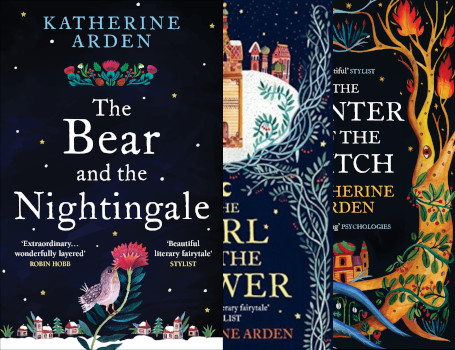I understand that Historical 14th Century Russian Folk Fantasy might not be the selling point for others that it is for me,1 but regardless, the Winternight Trilogy is something special. I can’t speak to the accuracy of Arden’s Rus, but the verisimilitude is impressive, from the frozen rural hold where the book starts, through to the proto-city of Moscow, all under the yoke of absent Tartar rulers. It is a land of hard work, resilient people, and of course magic.
And it is the magic that is at the heart of the book, an animistic world of grumpy house spirits, hungry river monsters, undead nightmares, and of course, the winter king. What distinguishes the magic here is that it feels lived in: a magic forest is still muddy, a golden bridle is still heavy, and of course a magical winter wonderland is still cold. Even as the series goes on and introduces us to wondrous creatures and powerful figures in Russian folk lore, the magic feels like a part of this world.
Of course a world is nothing without characters to inhabit it, and the siblings that dominate the story each bring something important to the world. Obviously at their heart, these are stories about Vasya, the prototypical fantasy tomboy, finding her place in the world and escaping medieval Russia’s strict gender roles. If there is anything conventional about these stories, it is that Vasya follows a fairly typical heroes journey, particularly in the first book – she has special powers, discovers her heritage/destiny, suffers loss, finds her power, and gets the ‘girl’. Fortunately however, she is an enormously well written hero, determined in the ways that matter, fragile in the ways a real person is, providing an anchor at the center of the series.
Her siblings however don’t really get a chance to shine until the later books. Olga initially comes across as the conventional sister, there to show that the alternative to Vasya’s choices is to literally be locked in a terem, Rapunzel style. However in The Girl in the Tower we get to see that Olga is much more than that. She is a savvy political player in Moscow, with the ear of the princess, partner to her husband, and most dangerously of all in middle ages Russia, mother of children. She is locked in her tower, but rather than be constrained by it, she has found space in it. It’s not an ideal modern life, but it is not a tragic one and her embrace of it is not a weakness. Ironically, it is Sasha, with all the freedom of a boy, that is in many ways the most lost. Initially the doting brother, he effectively runs away to become a monk, falls more into the role of a wandering knight, and seems to be constantly dragged along in the currents of history and his siblings wake.
In the same way that the world is Russia, but more, so is the cast. We have a range of characters who are well developed enough to be the protagonist of many other novels. The first novel begins with a doting father, makes way to an asthete priest, and rounds out with the winter king and the summer bear. The second gives us Moscow with its cunning and practical prince, wise priests, all in the shadow of the tartar. Interleaved through it all, though exploding in the third book are the Chyerti, the multitudinous spirits and deities of Russian folklore.
Arden also swings for the fences in terms of story. Obviously the books are anchored with Vasya’s story, each based around a supernatural foe for her to overcome. But there are other threads to the narrative. The most obvious for a Historical Fantasy Novel is the History. These are deliberately set at a time of upheaval at the founding of Russia, when the locals are trying to assert their independence from Mongol rule and forge their own identity. Arden captures the flow of history, with people drifting out of and into the story, and things that were unimaginable becoming inevitable. The second is the tension between Christianity and the folk beliefs of the Russian people, here literally personified in the Chyerti. Both of these narratives give the novels extra heft that elevate them.
Unfortunately however, they are also the third book’s downfall.2 In the Winter of the Witch, Vasya’s is bloodied beaten and almost defeated. She builds herself back up, overcomes her loss, and fully embraces her power by transcending her loss to defeat her foe and save the city that hurt her. This is two thirds of the way through the book. In the back of the book Arden talks about how the story was always going to end at the Battle of Kulikovo, and of course such a historical event is the perfect culmination of the weighty elements of the series. But for me, the tension was missing, as with Vasya’s journey complete, it felt more like an extended denouement that forced the story to a predefined event, rather than finding its natural end. Of course, this is more a minor speedbump, rather than a derailment of the series.
With the Winternight trilogy, Arden makes an absolutely stunning debut, and the Girl in the Tower is one of my favourite fantasy books of recent years. I wouldn’t recommend this to everyone, but anyone who likes historical fiction, folk tales, or just great fantasy should read this.
